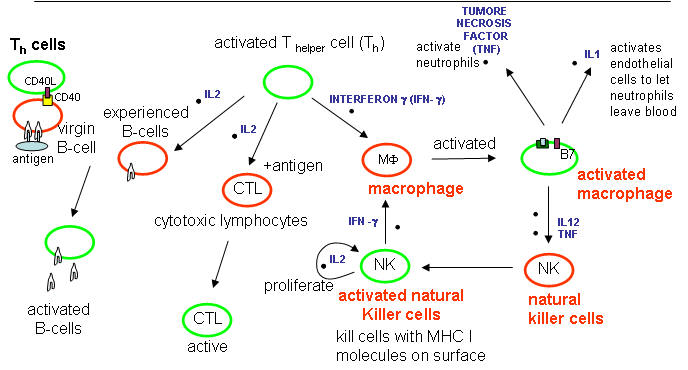Biochemistry Online: An Approach Based on Chemical Logic

CHAPTER 5 - BINDING
F: IMMUNE SYSTEM RECOGNITION
BIOCHEMISTRY - DR. JAKUBOWSKI
Last Updated: 03/14/13
|
Learning Goals/Objectives for Chapter 5E: After class and this reading, students will be able to
|
F4. Cytokines and Activation of Immune Cells
There are a large number of different cytokines that are released from immune cells. Some examples and their activities are shown in the diagram below and described in the text that follows. They are

Cytokines released from cells such as macrophages in the innate IS:
Tumor Necrosis Factor: TNF - from activated macrophages and dendritic cells. Main mediator of acute inflammation. Induces fever and sleep by acting on sites in the brain. Promote scar formation (excessive wound healing). Too much can cause shock. Acts on
-
endothelial cells that line all blood vessel walls
-
facilitates the movement of immune cells from the blood into tissues through the endothelial cells.
-
activates neutrophils activates macrophages which leads to IL1 secretion kills some tumor cells.
IL-1 - has similar properties as TNF IL-12 -
-
Activates NK and CTL.
-
Leads to release of INF-g from NK and T cells.
Interferon a, b, w : Are produced by virally-infected cells.
-
cause cells to degrade mRNA which kills virally-infected cells. The enzyme involved in RNA hydrolysis is inactive until the cell becomes infected with a virus. This protects uninfected cells.
Cytokines released after antigen activation of T cells in the adaptive immune system:
IL-2 - Produced by T helper cells (CD4)
-
leads to the proliferation of NK cells and T and B-lymphocytes that have been activated by antigen exposure.
Interferon-gamma (INF-g) - is also produced by activated T cells
-
increases the activity of other T cells (CTLs, NK cells. principle way to activate macrophages.
-
induces expression of MHC-I molecules, MHC-II molecules on antigen presenting cells to promote presentation
-
IFN-g stimulates the differentiation of T4-lymphocytes into activated T helper cells.
Chemokines are chemotactic cytokines, or protein that recruit other cells towards the site of release. Some examples are listed below:
-
MIP (Macrophage inflammatory factor, CCL3,4) recruit MI, NK cells, immature dendritic cells
-
RANTES (CCL5)
-
IL-8 (recruit neutophils)
-
IP10 recruit T cells
Navigation
Return to Chapter 5E: Immune System Recognition
Return to Biochemistry Online Table of Contents
Archived version of full Chapter 5F: Immune System Recognition

Biochemistry Online by Henry Jakubowski is licensed under a Creative Commons Attribution-NonCommercial 4.0 International License.